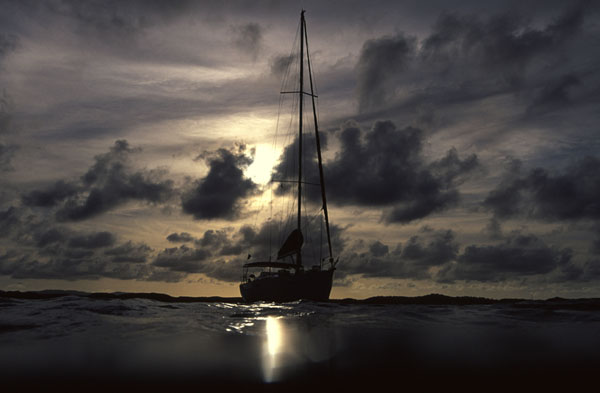Top 10 tips for crossing the Atlantic

As the Atlantic crossing season kicks off, here's my list of top things to prioritise
The Atlantic crossing season is here again and I'm at the start of the ARC rally in Las Palmas. So this seems like a good idea to recap on one of my most read blogs - top transatlantic tips.
It's derived from my own experience crossing the Atlantic, Indian Ocean and Pacific, plus covering more ARCs over the years than I care to admit to. Feel free to comment and add to them.
1. You don't need a special boat
Time was when a proper bluewater cruiser had chines, a ketch rig and self-steering gear at the stern. That was a perception, and perceptions change. Numerically, the most common transatlantic yachts these days are ordinary production cruisers with standard kit.
There's no black art to sailing 3,000 miles downwind. Generally, the toughest part of an Atlantic crossing is getting across Biscay. So whatever boat you have right now, the chances are that with a bit of extra prep she'll be fine for an Atlantic crossing.
As for a watermaker, generator, SSB radio, etc: they're all useful, but every additional item adds complication and service cost/time. Apart from a sound boat, all you really need is water, food, fuel and a (paper) copy of 'North Atlantic, Southern Part'.
2. Keep it simple
A smart crossing is all about consistent speed, 24 hours a day. The key is not to have downtime.
There's no need to fiddle around with twin headsails, Twistlerig or expensive new asymmetric spinnaker unless you particularly want to; a main and poled-out genoa 'barn doors' set-up will do fine. In fact, my husband and I won the ARC overall one year after sailing wing-and-wing almost the entire way.
Just keep an eye out for chafe, and be sure to set up a preventer on the boom and a foreguy topping lift and downhaul when poling out the headsail so you can furl in quickly when that night-time squall hits (which it will).
3. Revise your energy equation
Whatever power you think you'll use on an ocean crossing, add on another third. Nav lights, radar, radio scheds, autopilot, watermaker, fridge, freezer, computer, fans - you name it, they all add up.
Increase the means of generating electricity with a diesel generator, larger alternator, solar panels and/or a towed turbine and look at means of making savings, such as fitting LED lights.
4. Get some extra training
Ocean seamanship is more about fixing things and managing problems on board than navigation or routeing. Diesel engine maintenance, sea survival, medical and first aid training and courses run by manufacturers on servicing and maintaining their equipment are all invaluable preparation - for crew as well as skipper.
5. Make the most of your time out
Don't rush the opening stages of your year(s) off; enjoy the great summer cruising on the route down to the Canaries and other hopping-off points. The West Country, France, Northern Spain, Portugal and Madeira could be some of the best places you visit.
6. Take more crew for the crossing
Never underestimate how tiring ocean sailing can be and consider how hard-pressed you'd be two-handed if the autopilot were to break. Extra crew make life much easier and add to the stimulation.
You can find fresh new faces from Crewseekers , but do assess your compatibility first on a trial cruise.
7. Go the long way round
Some people spend thousands on routeing software, and that's fine. But you don't need it and if you're not used to using Grib files and don't have polars for your boat, it's of dubious value.
The most reliable passage plan is the simplest and often the quickest: run your latitude down to around 20°N, 30°W before turning right, following the age-old advice to 'head south til the butter melts'.
Here are three reasons to favour this route:
You'll pick up the tradewinds earlier. They often don't kick in properly until halfway across on the rhumb line route.
You'll get nicer conditions. Sometimes the direct route is upwind after the start or there's an uneasy cross sea from a depression to the north
The extra distance is only between 200 and 300 miles
You'll tick off 2-3 degrees of latitude a day, so it will get warmer quicker
8. Take it steady
Don't go all-out at the beginning of a crossing. It takes around three days for a crew to get their sea legs and settle down into a routine.
Just as importantly, your boat will be fully provisioned, fuelled and watered and that's tonnes of extra displacement. The increased loads on the gear and rigging are significant, so throttle back and don't push too hard too early.
9. Prepare for gear failure
Be prepared for key equipment to fail, because sooner or later it will. If it's gear you normally rely on, like an autopilot or watermaker, have a contingency.
10. Don't fix your arrival date in the diary
Some seasons an Atlantic crossing is quick; others it's slow. The weather varies quite a bit this side of Christmas. So if you are fixated on a certain arrival day, you'll be set up for disappointment before you even leave.
Keep your plans open. Remember that the crossing is the adventure, not the arrival in the Caribbean.
And whatever you do, don't let crew book flights immediately after your estimated ETA - nothing sours the atmosphere more than a stressed person on a deadline champing to be on land.